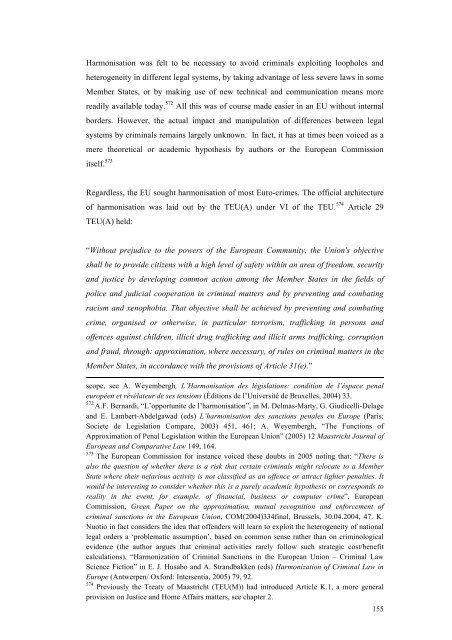The evolution of European Union criminal law (1957-2012)
The evolution of European Union criminal law (1957-2012)
The evolution of European Union criminal law (1957-2012)
Create successful ePaper yourself
Turn your PDF publications into a flip-book with our unique Google optimized e-Paper software.
Harmonisation was felt to be necessary to avoid <strong>criminal</strong>s exploiting loopholes and<br />
heterogeneity in different legal systems, by taking advantage <strong>of</strong> less severe <strong>law</strong>s in some<br />
Member States, or by making use <strong>of</strong> new technical and communication means more<br />
readily available today. 572 All this was <strong>of</strong> course made easier in an EU without internal<br />
borders. However, the actual impact and manipulation <strong>of</strong> differences between legal<br />
systems by <strong>criminal</strong>s remains largely unknown. In fact, it has at times been voiced as a<br />
mere theoretical or academic hypothesis by authors or the <strong>European</strong> Commission<br />
itself. 573<br />
Regardless, the EU sought harmonisation <strong>of</strong> most Euro-crimes. <strong>The</strong> <strong>of</strong>ficial architecture<br />
<strong>of</strong> harmonisation was laid out by the TEU(A) under VI <strong>of</strong> the TEU. 574 Article 29<br />
TEU(A) held:<br />
“Without prejudice to the powers <strong>of</strong> the <strong>European</strong> Community, the <strong>Union</strong>'s objective<br />
shall be to provide citizens with a high level <strong>of</strong> safety within an area <strong>of</strong> freedom, security<br />
and justice by developing common action among the Member States in the fields <strong>of</strong><br />
police and judicial cooperation in <strong>criminal</strong> matters and by preventing and combating<br />
racism and xenophobia. That objective shall be achieved by preventing and combating<br />
crime, organised or otherwise, in particular terrorism, trafficking in persons and<br />
<strong>of</strong>fences against children, illicit drug trafficking and illicit arms trafficking, corruption<br />
and fraud, through: approximation, where necessary, <strong>of</strong> rules on <strong>criminal</strong> matters in the<br />
Member States, in accordance with the provisions <strong>of</strong> Article 31(e).”<br />
scope, see A. Weyembergh, L’Harmonisation des législations: condition de l’éspace penal<br />
européen et révélateur de ses tensions (Éditions de l’Université de Bruxelles, 2004) 33.<br />
572<br />
A.F. Bernardi, “L’opportunite de l’harmonisation”, in M. Delmas-Marty, G. Giudicelli-Delage<br />
and E. Lambert-Abdelgawad (eds) L’harmonisation des sanctions penales en Europe (Paris:<br />
Societe de Legislation Compare, 2003) 451, 461; A. Weyembergh, “<strong>The</strong> Functions <strong>of</strong><br />
Approximation <strong>of</strong> Penal Legislation within the <strong>European</strong> <strong>Union</strong>” (2005) 12 Maastricht Journal <strong>of</strong><br />
<strong>European</strong> and Comparative Law 149, 164.<br />
573 <strong>The</strong> <strong>European</strong> Commission for instance voiced these doubts in 2005 noting that: “<strong>The</strong>re is<br />
also the question <strong>of</strong> whether there is a risk that certain <strong>criminal</strong>s might relocate to a Member<br />
State where their nefarious activity is not classified as an <strong>of</strong>fence or attract lighter penalties. It<br />
would be interesting to consider whether this is a purely academic hypothesis or corresponds to<br />
reality in the event, for example, <strong>of</strong> financial, business or computer crime”, <strong>European</strong><br />
Commission, Green Paper on the approximation, mutual recognition and enforcement <strong>of</strong><br />
<strong>criminal</strong> sanctions in the <strong>European</strong> <strong>Union</strong>, COM(2004)334final, Brussels, 30.04.2004, 47. K.<br />
Nuotio in fact considers the idea that <strong>of</strong>fenders will learn to exploit the heterogeneity <strong>of</strong> national<br />
legal orders a ‘problematic assumption’, based on common sense rather than on criminological<br />
evidence (the author argues that <strong>criminal</strong> activities rarely follow such strategic cost/benefit<br />
calculations), “Harmonization <strong>of</strong> Criminal Sanctions in the <strong>European</strong> <strong>Union</strong> – Criminal Law<br />
Science Fiction” in E. J. Husabo and A. Strandbakken (eds) Harmonization <strong>of</strong> Criminal Law in<br />
Europe (Antwerpen/ Oxford: Intersentia, 2005) 79, 92.<br />
574 Previously the Treaty <strong>of</strong> Maastricht (TEU(M)) had introduced Article K.1, a more general<br />
provision on Justice and Home Affairs matters, see chapter 2.<br />
155
















